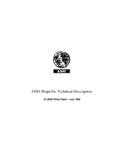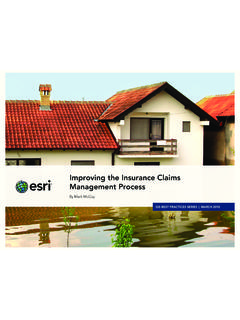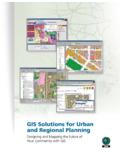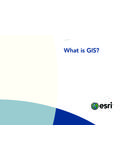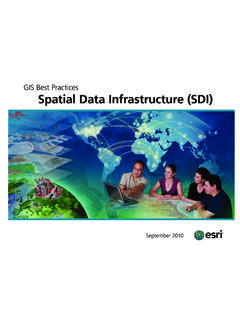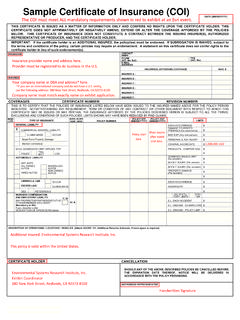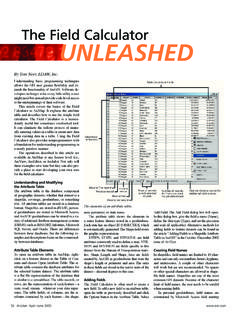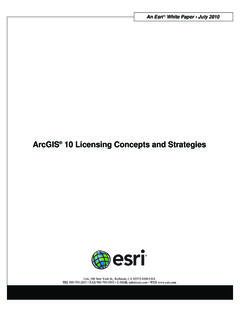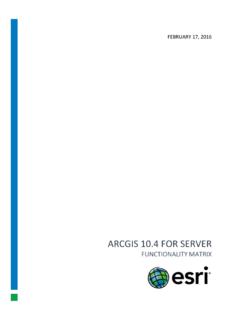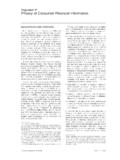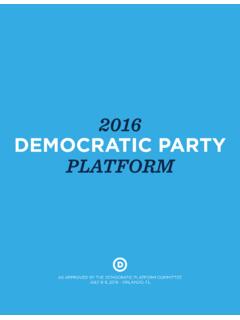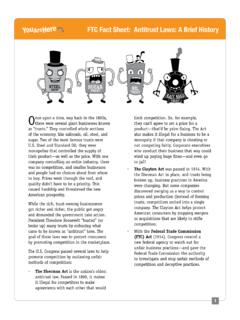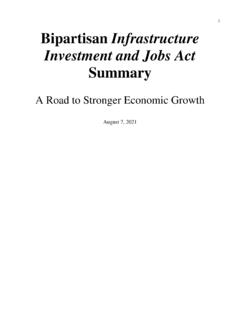Transcription of Content Management Strategies for your ArcGIS Enterprise ...
1 Content Management Techniques for your ArcGIS Enterprise Portal March 2020 Copyright 2020 Esri All rights reserved. Printed in the United States of America. The information contained in this document is the exclusive property of Esri. This work is protected under United States copyright law and other international copyright treaties and conventions. No part of this work may be reproduced or transmitted in any form or by any means, electronic or mechanical, including photocopying and recording, or by any information storage or retrieval system, except as expressly permitted in writing by Esri.
2 All requests should be sent to Attention: Contracts and Legal Services Manager, Esri, 380 New York Street, Redlands, CA 92373-8100 USA. The information contained in this document is subject to change without notice. Esri, the Esri globe logo, The Science of Where, ArcGIS , , and are trademarks, service marks, or registered marks of Esri in the United States, the European Community, or certain other jurisdictions. Other companies and products or services mentioned herein may be trademarks, service marks, or registered marks of their respective mark owners. Content Management Techniques for your ArcGIS Enterprise Portal AN ESRI WHITE PAPER 3 Content Management Techniques for your ArcGIS Enterprise Portal Your ArcGIS Enterprise portal, as part of ArcGIS Enterprise , is a powerful way to create, organize, secure, and share spatial and non-spatial Content .
3 It centralizes information so that it can be available to the right people at the right time. For many, it is where your layers, maps, files, surveys, dashboards, and applications are organized and discovered. It is also a platform in which to build applications showcasing the work of your organization. As the ArcGIS Enterprise portal is the gateway to your data and information, administrators, Content managers, and GIS professionals often strive to provide the best experience possible. This can be visual, like creating beautiful maps and apps, but also structural, such as providing the right level of access to the right users.
4 This whitepaper will cover best practices and tips across many facets of Content Management , from user access, to Content creation, to displaying and showcasing your data. The goal is to equip you with techniques to make the best use of your Enterprise portal. With a bit of planning and execution, you can make it an even more enjoyable and informational asset for your organization. Notes: This whitepaper takes a more getting started perspective, though you may find this information useful if you have been working with your Enterprise portal for some time and need to revisit your approach to Content Management .
5 Many of the concepts here apply to ArcGIS Online as well. Content Management Techniques for your ArcGIS Enterprise Portal AN ESRI WHITE PAPER 4 Table of Contents Enable users with the right level of access .. 5 Match users with user types .. 5 Leverage member roles .. 5 Create a convention for usernames .. 6 Develop a strategy for creating and managing 8 Strategize how and what Content is created .. 8 Take advantage of data maintenance capabilities .. 9 Use Content provided by Esri .. 9 Monitor Content .. 10 Enforce good quality Content and context .. 12 Describe Content using metadata.
6 12 Use appropriate tags .. 13 Categorize Content .. 14 Assign and use badges .. 15 Manage access to Content .. 17 Share Content within your organization .. 17 Share Content across organizations .. 18 Display and showcase Content .. 19 Display items in your ArcGIS Enterprise 19 Showcase information using ArcGIS Enterprise Sites .. 20 Build configurable applications .. 21 Takeaways .. 22 Content Management Techniques for your ArcGIS Enterprise Portal AN ESRI WHITE PAPER 5 Enable users with the right level of access Content Management Strategies are often centered around ensuring that people have access to and are using the right data and information.
7 While this whitepaper covers that concept in detail, it begins with an even more foundational topic: ensuring that users have access to the right capabilities within ArcGIS Enterprise to do their work. For example, ensuring that editors can edit data, Content creators can author and publish Content , and administrators have administrative access. Within ArcGIS Enterprise , this is controlled through user types, roles, and privileges. Match users with user types User types determine what high-level capabilities each member (user) will have. It is likely that there will be some members in your organization that just need to view Content , some who will edit, and some who will need to do everything view, edit, create, analyze, and administer.
8 User types match these common needs and personas. For example, if you have a member who just needs to view data, you can assign them the Viewer user type. The five general purpose user types in ArcGIS Enterprise are: Each member of ArcGIS Enterprise is assigned a user type by their administrator as their account is created. This can always be reassigned if needed. For example, if a member, Samantha, joined as a Viewer, but has now shown interest in editing data, her administrator can reassign her user type to Editor, which provides view + edit capabilities. Note that in order to take advantage of different user types, they will need to be included in your Enterprise portal license.
9 Leverage member roles As shown, user types determine the high-level capabilities of each member view, edit, create, analyze, administer. This is then refined though the use of member roles and privileges. Member roles are sets of privileges and allow privileges to be quickly and systematically assigned. When privileges have been assigned through member roles, certain actions in ArcGIS Enterprise are allowed/shown. Privileges are divided up between general privileges for groups, Content , sharing, analysis, and Content Management Techniques for your ArcGIS Enterprise Portal AN ESRI WHITE PAPER 6 editing, and administrative privileges for members, groups, Content , and system settings.
10 For example, if Samantha is assigned a role that doesn't include the 'edit features' privilege, editing options will be inaccessible to her. There are five built in roles in ArcGIS Enterprise : Viewer, Data Editor, User, Publisher, and Administrator. Each of these roles include a set of privileges relating to the function of the name ( Publishers can create and publish Content , among other privileges). It is common to use both built in roles as well as custom roles, which are roles that you, an administrator, have created to match your user base. As an example, an administrator could create the following custom roles: Contractors who can create and edit data but can t view Content shared with the organization.
